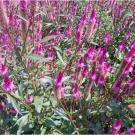This presentation is from the project "Increasing production of indigenous African leafy vegetables," led by Stephen Weller, Purdue University. It highlights the project's objectives and results.
Co-principal investigators from the U.S.:
- Maria I. Marshall, Purdue University
- Mathieu Ngouajio, Michigan State University
- Dharma Pitchay, Tennessee State University
Co-principal investigators from Kenya and Tanzania:
Kenya:
- AMPATH: Pamela Obura, Naman Nyabinda, Naiomi Lundman, and Benjamin Andama
- Moi University: Elizabeth Omani, Grace Cheserek, and Julius Ochuodho
- KARI: Christine Ndinya
Tanzania
- AVRDC World Vegetable Center: Chris Ojiewo.
Objective 1. Assessment and enhancement of genetic resources of African leafy vegetables: On station germplasm was used in experiments, evaluated, and data was collected on germination percentages, days to 50% flowering, fresh biomass and seed yield. On-farm demonstrations, participatory farmer evaluations, and educational field days were carried out. Evaluation was done on morphological and organoleptic traits. The presentation includes preferred African leafy vegetable varieties (amaranth, nightshade, and spider plant) from participatory evaluation, and participants' survey responses from the field days.
Objective 2. Improving African leafy vegetable seed system availability to stakeholders: There was promising germplasm identified during participatory evaluations, and the project selected farmers from each of the five sites to receive practical training on seed agronomy, harvesting, processing and storage/preservation. The project also used on-farm demonstration plots to collect seeds to be shared with group members and sold to neighbors.
Objective 3. Development and dissemination of improved horticulture practices and post harvest technologies for African leafy vegetables: The project acquired training materials on best management practices for African leafy vegetables and supplemental extension materials. It incorporated indigenous knowledge and utilized a local training team with AMPATH extension staff and KARI and Moi University researchers, with technical back up provided by U.S. collaborators.
Objective 4: Promote educational programs on African leafy vegetables for farmers and other community groups: The project conducted group farmer training sessions, regular field visits by AMPATH extension staff, and field days/group meetings. Topics covered were land preparation, planting methods, seed quality, crop management, harvesting techniques, value-addition and recipes, and record keeping.
Objective 5. Develop marketing strategies for African leafy vegetables: The project carried out household and market surveys in the five sites and dissemination of information to producers on market locations, capacity and required quality. In addition, it held a peer networking day for producers and vendors.
Other content: The presentation also includes graphs showing household/producer demographic characteristics, income, land allocation, a summary of results from the market survey, as well as graphs on the popularity of nightshade, amaranth, and spider plant by region. It also has tables that compare market prices for African leafy vegetables compared to other popular leafy vegetables like kale, cabbage, and spinach, including across the dry and wet season.
Project outcomes and lessons learned:
- Availability of improved African leafy vegetable germplasm
- Farmers acquired valuable skills on improved best management practices, post harvest handling and utilization of indigenous African leafy vegetables
- Enhanced the capacity of local extension staff and farmers in the maintenance of germplasm and sustainable community seed system for their preferred indigenous vegetable
- Improved knowledge/awareness, practices and attitudes, among community members, extension staff with regards to nutritional values of indigenous vegetables.
- Integration of agriculture, gender, HIV/AIDS, nutrition and environment components in existing community development programs such as AMPATH
- Increased awareness in the community on group dynamics and resource mobilization

